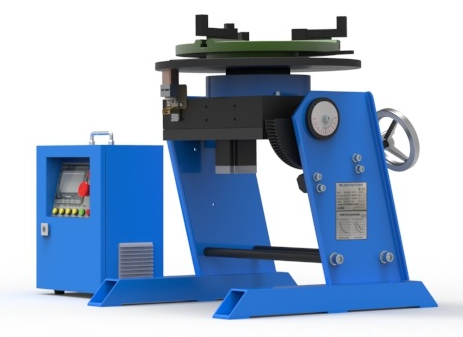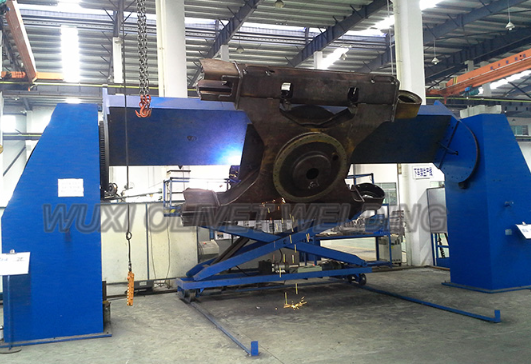When operating a welding positioner, safety is always the top priority. It is important to ensure you're your welding positioner is always secure to a flat, stable surface. Benchtop welding positioners should be secured as well.
Positioning devices, whether purchased or rented, are accessory tools that can be implemented in the welding process by holding, lifting, and rotating parts, somewhat like a rotisserie chicken. Generally, these devices are categorized as either single-column or tailstock/headstock positioners, and control orientation with certain types of rotators to allow 360 degrees of rotation for easy access. Headstocks and tailstocks control the weldment's height for aid in rotation and are synchronized to stay level. A single operator can easily run these machines alone.
Automatic Welding Positioner
Not just used for large assemblies, positioning equipment is also ideal for use on smaller projects. The good news here is that, regardless of the size of your weldment, the principles of positioning are the same. Your base product is secured to the equipment via clamps or bolts, and then mechanically guided into an orientation that allows you the most effective and comfortable position to weld and assembles in. As parts are added, the whole weldment can be moved to gain easy access to weld joints. Coordinated with robotic welding, positioners can even speed up operations.
Regardless of size, a properly positioned weldment saves space and increases safety and productivity. These devices also aid in reducing welder fatigue, which, in turn, improves weld quality. By being able to move the weldment mechanically to position it within your comfortable range of movement, you are not forced to weld at odd angles, allowing you to work at your best for longer. By anchoring your weldment to an appropriate device, you can further improve workshop safety. Slings, chains, cranes, and other similar methods can create uncontrolled motion, which can be dangerous. By utilizing a suitable positioning device, you avoid needing to place yourself under a most likely heavy weldment, reducing risk of injury from a possible faulty device, and also from falling slag and sparks.
No matter the weldment size, you should keep the following in mind when choosing, operating, and maintaining a positioner:
Points to Know When Working on Weld Positioners
Here are some things workers should keep in mind when welding on a weld positioner:
ㆍThe center of gravity is the point where the mass of an object is held. So, when you select the positioning weld, it is important to consider the center of gravity of that workpiece along with its size and weight. This facilitates an equal balance of the workpiece on all axes. This also determines the speed of rotation of the table. CoG will change when the welder adds parts of various weights and sizes to the positioner. This point also needs to be considered.
ㆍThe way in which the workpiece is anchored onto the welding positioner is a crucial factor because this is also the way in which it would separate once the task is done. Some specific tasks which need to be repeated to produce parts for typical applications use unique production fixtures. Other than this, for round-shaped workpieces, usually, a three-jaw chuck may be used for attachment to the positioner. Some pieces need to be bolted. So, this needs to be figured out according to the shape and size of the workpiece.
ㆍEnsure that the whole weld positioner unit is mounted onto a flat, even surface. Else, the workpiece may fall off, and this could be dangerous. You can mount the positioner vertically onto a workbench or a stand; however, it must be fastened well.
ㆍIt is also important to check the manufacturer specifications for your welding positioner. The motor and control are based on the size and speed required for the welder to perform, and the manufacturer's specifications will inform you whether the welding positioner can handle the operation you need to perform.
ㆍA ground current should also be connected to the positioner during welding. Without it, electrical parts can be damaged. You should also make sure that the positioner is compatible with the electric current produced by the welding process.
CENTER OF GRAVITY (COG)
When selecting a positioning device, it is just as important to take the weldment's center of gravity (COG) into account – and how far away it is from the positioning device – as well as its weight and size. The COG is the point of the weldment that balances equally on all axes, and the further away a weldment's COG is from the device, the more torque that is applied to the positioner. Bear in mind, as you add material and parts to the positioner, your weldment's COG will change and should be taken into account.
CORRECT ATTACHMENT
How you attach the weldment to the device is just as important as the positioner itself. Positioners have fixtures permanently attached that have been designed for specific, repetitious actions, and their specific shapes allow for easy part alignment. Fixtures and chucks add additional weight and distance to the faceplate and should be taken into consideration when positioning and sizing. Also keep in mind that while the weight of the weldment will apply torque to the positioner, the distance that weight is applied multiplies the torque by the increase in distance, which may require a larger machine.

Double Column Positioner
CYLINDERS
Turning rolls are useful if the weldment you are working on is cylindrical. There are two types of roller positioners – idler and powered. Powered rolls provide stable, constant rotation to help give you uniform border welds. Idler rolls, however, are not mechanized and can be added to powered rolls to provide support for longer cylindrical weldments. This combination supplies additional safety and stability, and when the rollers have two points of contact, the weight is evenly distributed and the COG is adequately supported.
ORIENTATION
Keep it flat, even with small positioning devices. It is important that the equipment is mounted to an even, flat surface to avoid the entire thing toppling over when encountering an unexpected force. Use mounting holes when provided, and be sure to secure positioners mounted to stands or workbenches.
CONNECT GROUND CURRENTS
While welding, make sure any ground currents are connected to the device to avoid mechanical damage and having to replace the welding clamp often. The ground current will transfer from the table and into the positioner's chassis and will save the equipment's electrical parts from becoming damaged and, thus, prevent subpar welds. It will also save you the hassle – and cost – of continuous removal and exchange of welding clamps.
What are the Different Applications of Weld Positioners?
Weld positioners are commonly used in many industries where welding and fabrication are required. Here are some of the application areas of weld positioners:
ㆍRotary positioning
ㆍRotation of parts for assembling
ㆍMounting of welding equipment
ㆍWelding of shafts, wheels, pipes, and more
ㆍRotating workpieces with huge offset loads
By using welding positioners, you will put yourself in a position to consistently produce high-quality welds. These devices can allow for reduced rejection rates with increased precision on complex projects and jobs, while also providing welder comfort. In addition, manufacturing costs of positioners often tend to be lower than that of a standard rotary table. We are a welding positioner supplier, please contact us if you need them!
Related Products:
FITZ Growing Line
Welding Turntable
Pipe Supporting Roller
Pipe Pinching Rotator
Welding Rotator
Pipe Welding Chucks
Light Duty Positioner
Light Duty Weld Positioner
Wind Tower Production Line
Welding manipulator
Pipe Welding Positioner

没有评论:
发表评论